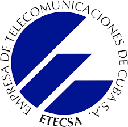Executive Secretary

21st International Symposium on Electrical Engineering
SIE 2025
Abstract
The incorporation of Fixed Wireless Access (FWA) technology in Cuba represents a viable alternative to expand connectivity in rural and urban areas where traditional services, such as Nauta Hogar (ADSL), have coverage and speed limitations. Given the national context, the deployment of LTE FWA networks can facilitate access to advanced services, including interactivity applications, video on demand, audience measurement and educational platforms, through the integration of devices that generate Wi-Fi networks for end users. In this work, some experimental tests of the FWA technology are performed to evaluate its performance and feasibility in the local environment (simulated and real). However, modifying the hardware of the prototype Set-Top Box (STB) initially designed to work with ADSL or as a FWA receiver is extremely complex due to the technological and architectural differences between these systems. The implementation of FWA-based solutions requires careful evaluation of the advantages offered by this technology, such as greater flexibility in service distribution and potential improvements in connection quality and speed, versus the technical difficulties associated with its integration into existing devices.
Resumen
La incorporación de la tecnología Fixed Wireless Access (FWA) en Cuba representa una alternativa viable para ampliar la conectividad en zonas rurales y urbanas donde los servicios tradicionales, como Nauta Hogar (ADSL), presentan limitaciones en cobertura y velocidad. Dado el contexto nacional, el despliegue de redes LTE FWA puede facilitar el acceso a servicios avanzados, incluyendo aplicaciones de interactividad, video bajo demanda, medición de audiencias y plataformas educativas, mediante la integración de dispositivos que generen redes Wi-Fi para los usuarios finales. En este trabajo se realizan algunas pruebas experimentales de la tecnología FWA para evaluar su desempeño y viabilidad en el entorno local (simuladas y reales). Sin embargo, modificar el hardware del prototipo de Set-Top Box (STB) diseñado inicialmente para funcionar con ADSL o como receptor FWA resulta sumamente complejo debido a las diferencias tecnológicas y arquitectónicas entre estos sistemas. La implementación de soluciones basadas en FWA requiere evaluar cuidadosamente las ventajas que ofrece esta tecnología, como mayor flexibilidad en la distribución del servicio y potenciales mejoras en la calidad y velocidad de conexión, frente a las dificultades técnicas asociadas a su integración en dispositivos existentes.
About The Speaker

MsC. irina siles siles

Discussion


 Bronze
Bronze